Duiker William J., Spielvogel Jackson J. The Essential World History
Подождите немного. Документ загружается.


In France, the confusion that ensued after the col-
lapse of Louis Napoleon’s Second Empire finally ended in
1875 when an improvised constitution established a re-
publican form of government---the Third Republic---that
lasted sixty-five years. France’s parliamentary system was
weak, however, because the existence of a dozen political
parties forced the premier (or prime minister) to depend
on a coalition of parties to stay in power. The Third
Republic was notorious for its changes of government.
Nevertheless, by 1914, the French Third Republic com-
manded the loyalty of most French people.
Central and Eastern Europe:
Persistence of the Old Order
The constitution of the new imperial Germany begun by
Chancellor Otto von Bismarck in 1871 provided for a
bicameral legislature. The lower house of the German
parliament, the Reichstag, was elected by universal male
suffrage, but it did not have ministerial responsibility.
Ministers of government, among whom the most im-
portant was the chancellor, were responsible to the em-
peror, not the parliament. The emperor also commanded
the armed forces and controlled foreign policy and the
government.
During the reign of Emperor William II (1888--
1918), the new imperial Germany begun by Bismarck
continued as an ‘‘authoritarian, conservative, military-
bureaucratic power state.’’ By the end of William’s reign,
Germany had become the strongest military and indus-
trial power on the Continent, but the rapid change had
also helped produce a society torn between moderniza-
tion and traditionalism. With the expansion of industry
and cities came demands for true democracy. Conserva-
tive forces, especially the landowning nobility and in-
dustrialists, two of the powerful ruling groups in imperial
Germany, tried to block the movement for democracy by
supporting William II’s activist foreign policy. Expansion
abroad, they believed, would divert people’s attention
from the yearning for democracy at home.
After the creation of the dual monarchy of Austria-
Hungary in 1867, the Austrian part received a constitu-
tion that theoretically established a parliamentary system.
In practice, however, Emperor Francis Joseph (1848--
1916) largely ignored parliament, ruling by decree when
parliament was not in session. The problem of the various
nationalities also remained troublesome. The German
minority that governed Austria felt increasingly threat-
ened by the Czechs, Poles, and other Slavic groups within
the empire. Their agitation in the parliament for auton-
omy led prime ministers after 1900 to ignore the parlia-
ment and rely increasingly on imperial decrees to govern.
In Russia, the assassination of Alexander II in 1881
convinced his son and successor, Alexander III (1881--
1894), that reform had been a mistake, and he lost no
time in persecuting both reformers and revolutionaries.
When Alexander III died, his weak son and successor,
Nicholas II (1894--1917), began his rule with his father’s
conviction that the absolute power of the tsars should be
preserved: ‘‘I shall maintain the principle of autocracy just
as firmly and unflinchingly as did my unforgettable
father.’’
6
But conditions were changing.
Industrialization progressed rapidly in Russia after
1890, and with industrialization came factories, an in-
dustrial working class, and the development of socialist
parties, including the Marxist Social Democratic Party
and the Social Revolutionaries. Although repression
forced both parties to go underground, the growing op-
position to the tsarist regime finally exploded into revo-
lution in 1905.
The defeat of the Russians by the Japanese in 1904--
1905 encouraged antigovernment groups to rebel against
the tsarist regime. Nicholas II granted civil liberties and
created a legislative assembly, the Duma, elected directly
by a broad franchise. But real constitutional monarchy
proved short-lived. By 1907, the tsar had curtailed the
power of the Duma and relied again on the army and
bureaucracy to rule Russia.
International Rivalries and the Winds of War
Bismarck had realized in 1871 that the emergence of a
unified Germany as the most powerful state on the
CHRONOLOGY
The National State, 1870--1914
Great Britain
Formation of Labour Party 1900
National Insurance Act 1911
France
Republican constitution (Third Republic) 1875
Germany
Bismarck as chancellor 1871--1890
Emperor William II 1888--1918
Austria-Hungary
Emperor Francis Joseph 1848--1916
Russia
Tsar Alexander III 1881--1894
Tsar Nicholas II 1894--1917
Russo-Japanese War 1904--1905
Revolution 1905
484 CHAPTER 19 THE BEGINNINGS OF MODERNIZATION

Continent (see Map 19.3) had upset the balance of power
established at Vienna in 1815. Fearful of a possible anti-
German alliance between France and Russia, and possibly
even Austria, Bismarck made a defensive alliance with
Austria in 1879. Three years later, this German-Austrian
alliance was enlarged w ith the entrance of Italy, angry
with the French over conflicting colonial ambitions in
North Africa. The Triple Alliance of 1882---Germany,
Austria-Hungary, and Italy---committed the three powers
to a defensive alliance against France. At the same time,
Bismarck maintained a separate treaty with Russia.
When Emperor William II cashiered Bismarck in
1890 and took over direction of Germany’s foreign policy,
he embarked on an activist foreign policy dedicated to
enhancing German power by finding, as he put it, Ger-
many’s rightful ‘‘place in the sun.’’ One of his changes in
Bismarck’s foreign policy was to drop the treaty with
Russia, which he viewed as being at odds with Germany’s
Cyprus
Crete
Sicily
Sardinia
Corsica
Black Sea
Atlantic
Ocean
Arctic Ocean
FINLAND
GREECE
MOROCCO
ALGERIA
TUNISIA
ITALY
SPAIN
PORTUGAL
FRANCE
GREAT
BRITAIN
BELGIUM
NETHERLANDS
LUXEMBOURG
SWITZERLAND
AUSTRIA
HUNGARY
ROMANIA
SERBIA
BULGARIA
BOSNIA
HERZ.
MONTENEGRO
ALBANIA
M
A
C
E
D
O
N
I
A
CROATIA -
SLOVENIA
B
E
S
S
A
R
A
B
I
A
CRIMEA
RUSSIAN
EMPIRE
OTTOMAN EMPIRE
Athens
Naples
Rome
Venice
Tunis
Algiers
Tangier
Lisbon
Madrid
Marseilles
Paris
Munich
London
Saint Petersburg
Moscow
Kiev
Odessa
Sinope
Constantinople
Budapest
Sevastopol
R
h
i
n
e
R
.
V
o
l
g
a
R
.
P
o
R
.
E
b
r
o
R
.
A
l
p
s
T
a
u
r
u
s
M
t
s
.
B
a
l
e
a
r
i
c
I
s
l
a
n
d
s
P
y
r
e
n
e
e
s
Mediterranean Sea
North
Sea
Baltic
Sea
POLAND
DENMARK
NORWAY
and
SWEDEN
AUSTRIA-
HUNGARY
Kristiania
Stockholm
Helsingfors
Prague
Warsaw
Dresden
Berlin
Copenhagen
E
l
b
e
R
.
Vienna
O
d
e
r
R
.
D
a
n
u
b
e
R
.
German Empire
Austria-Hungary
Italy
France
Ottoman Empire
0 250 500 Miles
0 250 500 750 Kilometers
MAP 19.3 Europe in 1871. German unification in 1871 upset the balance of power
established at Vienna in 1815 and eventually led to a realignm ent of European alliances.
By 1907, Europe was divided into two opposing camps: the Triple Entente of Great Britain,
Russia, and France and the Triple Alliance of Germany, Austria-Hungary, and Italy.
Q
How was Germany affected b y the formation of the Triple Entente?
View an animated version of this map or related maps at www .c engage.com/ history/
duikspiel/essentialworld6e
THE EUROPEAN STATE, 1871--1914 485
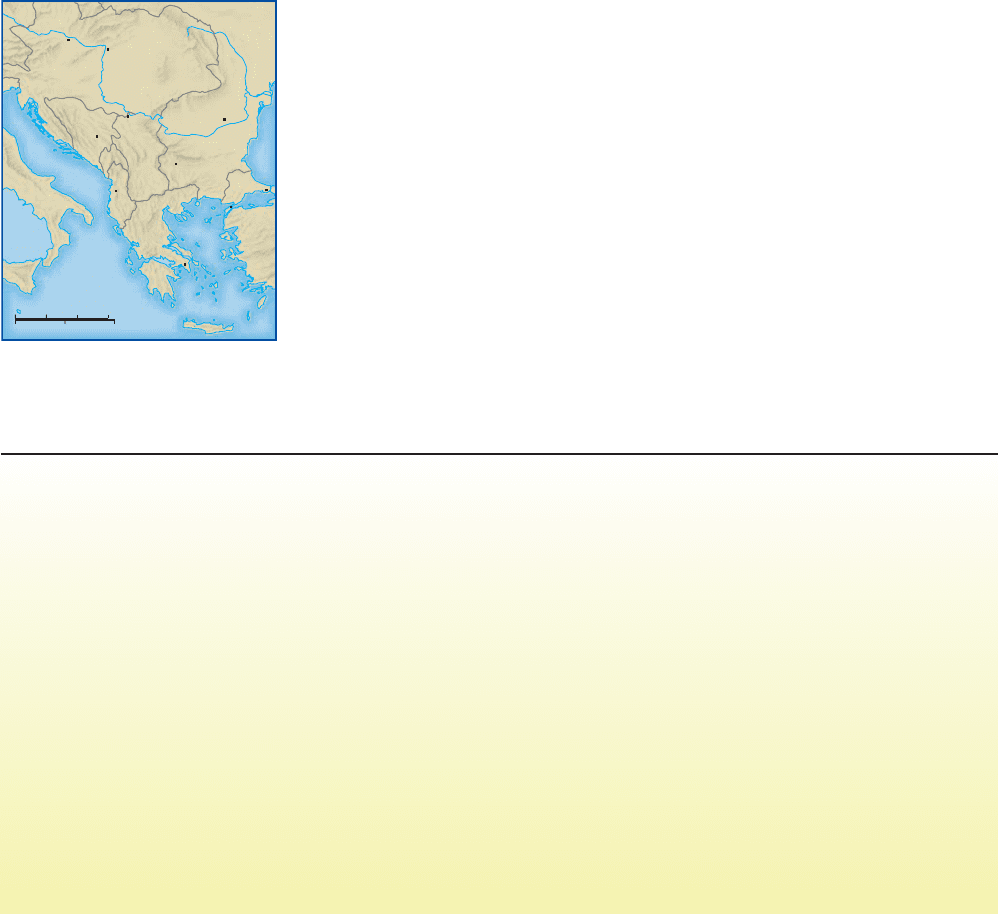
alliance with Austria. The ending of the alliance brought
France and Russia together, and in 1894, the two powers
concluded a military alliance. During the next ten years,
German policies abroad caused the British to draw closer
to France. By 1907, an alliance of Great Britain, France,
and Russia---known as the Triple Entente---stood opposed
to the Triple Alliance of Germany, Austria-Hungary, and
Italy. Europe became divided into two opposing camps
that became more and more inflexible and unwilling to
compromise. A series of crises in the Balkans between
1908 and 1913 set the stage for World War I.
Crisis in the Balkans Over the course of the nine-
teenth century, the Balkan provi nces of the Ottoman
Empire had gradu-
ally gained their
freedom, although
the rivalry in the re-
gion between Austria
and Russia compli-
cate d the process. By
1878, Greece, Serbia,
and Romania had
become independent
states. Although freed
from Ottoman rule,
Montenegro was
placed under an
Austrian protector-
ate, while Bulgaria
achieved autonomous status under Russian protection.
Bosnia and Herzegovina were placed under Austrian
protection; Austria could occupy but not annex them.
Nevertheless, in 1908, Austria did annex the two
Slavic-speaking territories. Serbia was outraged because
the annexation dashed the Serbs’ hopes of creating a
large Serbian kingdom that would unite most of the
southern Slavs. The Russian s, as protectors of their
fellow Slavs, suppor ted the Ser bs and opposed the
Austrian action. Backed by the Russians, the Serbs
prepared for war against Austria. At this point, William
II inter vened and demanded that the Russians accept
Austria’s annexation of Bosnia and Herzegovina or face
war with Germany. Weakened from their defeat in the
Russo-Japanese War in 1904--1905, the Russians backed
down but vowed revenge. Two wars between the Balkan
states in 1912--1913 further embittered the inhabitants
of the region and generated more tensions among the
gre at powers.
Serbia’s desire to create a large Serbian kingdom
remained unfulfilled. In their frustration, Serbian na-
tionalists blamed the Austrians. Austria-Hungary was
convinced that Serbia was a mortal threat to its empire
and must at some point be crushed. As Serbia’s chief
supporters, the Russians were determined not to back
down again in the event of a confrontation with Austria or
Germany in the Balkans. The allies of Austria-Hungary
and Russia were also determined to be more supportive of
their respective allies in another crisis. By the beginning of
1914, two armed camps viewed each other with suspicion.
D
a
n
u
b
e
R
.
M
e
d
i
t
e
r
r
a
n
e
a
n
S
e
a
A
d
r
i
a
t
i
c
S
e
a
Black
Sea
P
r
u
t
h
R
.
GERMANY
ITALY
GREECE
SERBIA
ALBANIA
MONTENEGRO
BULGARIA
ROMANIA
RUSSIA
AUSTRIA-HUNGARY
BOSNIA AND
HERZEGOVINA
O
T
T
O
M
A
N
E
M
P
I
R
E
Tirana
Vienna
Belgrade
Sarajevo
Budapest
Athens
Constantinople
Bucharest
Sofia
Gallipoli
C
a
r
p
a
t
h
i
a
n
M
t
s
.
Sicily
Crete
MACEDONIA
TRANSYLVANIA
0 100 200 Miles
0 100 200 300 Kilometers
The Balkans in 1913
CONCLUSION
THE FORCES UNLEASHED between 1800 and 1870 by
two revolut ions---the French Revolution and the In dustrial
Revolution---led to Wester n global dominance by the end of the
nineteent h century. The First and Secon d Industrial Revolu tions
seemed to prove to Europeans the underlying a ssumption of the
Scientific Revolution of the seventeenth century---that human
beings were capable of dominating nature. By rationally
manipulating the material environment for human benefit, people
could achieve new levels of material prosperity and produce
machines hitherto not dreamed of in their wildest imaginings.
Some of these new machines included weapons of war that
enabled the Western world to devastate and dominate non-
Western civilizations.
In 1815, a conservative order had been reestablished
throughout Europe, but the revolutionary waves in Europe in the
first half of the nineteenth centur y made it clear that the ideologies
of liberalism and nati onalism, unl eashed by the French Revolution
and now reinforced by the spread of industrialization, were still
alive and active. Between 1850 and 1871 , the national state became
the focus of people’s loyalty. Wars, both foreign and civil, were
fought to create unified nation-states, and both wars and changing
political alignments served as catalysts for domestic reforms that
made the nation-state the center of attention. Liberal nationalists
had believed that unified nation-states would preserve individual
rights and lead to a greater community of peoples. But the new
nationalism of the late nineteenth century, loud and patriotic, did
not unify peoples but div ided them instead as the new national
states became embroiled in bitter competition after 1871.
Between 1871 and 1914, the national state began to expand
its functions beyond all previous limits. Fearful of the growth of
socialism and trade unions, governments attempted to appease
the working mas ses by adopting such social insurance measures
as compensation for accidents, illness, and old age. These social
welfare m easures provided o nly limited ben efits before 1914, but
they signaled a new direction for state action to benefit all
citizens.
486 CHAPTER 19 THE BEGINNINGS OF MODERNIZATION
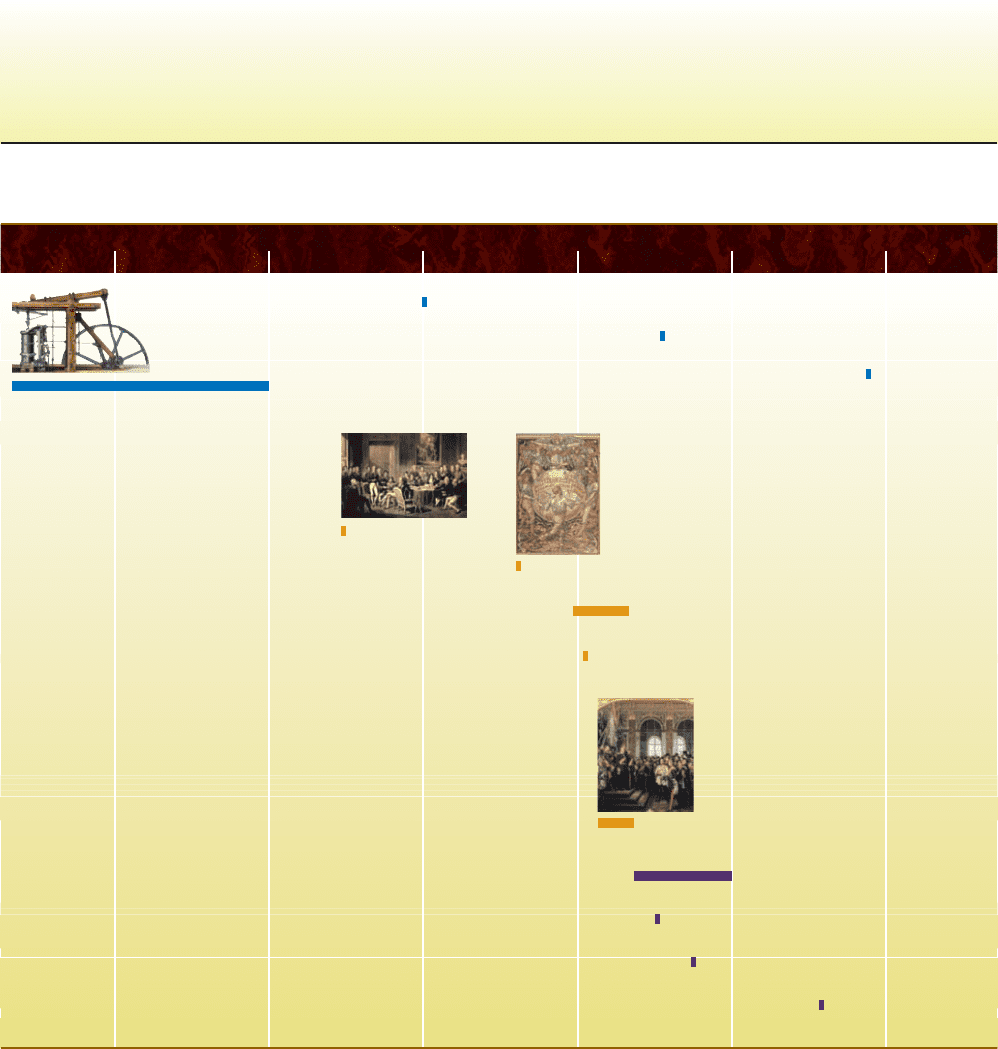
SUGGESTED READING
The Industrial Revolution and Its Impact Still a good
introduction to the Industrial Revolution is the well-written work by
D. Landes, The Unbound Prometheus: Technological Change and
Industrial Development in Western Europe from 1750 to the
Present (Cambridge, 1969). Also valuable is J. Horn, The Industrial
Revolution (Westport, Conn., 2007). For a broader perspective, see
P. Stearns, The Industrial Revolution in World History (Boulder,
Colo., 1993). On the role of the British, see K. Morgan, The Birth
of Industrial Britain: Social Change, 1750--1850 (New York, 2004).
On the social impact of the Industrial Revolution, see P. Pilbeam,
The Middle Classes in Europe, 1789--1914 (Basingstoke, England,
1990), and J. G. Williamson, Coping with City Growth During the
British Industrial Revolution (Cambridge, 2002).
TIMELINE
1770
1800 1830 1860 1890 1920
Beginning of the Industrial Revolution in Britain
Stephenson's Rocket
Bell invents the telephone
Mass production of
Ford's Model T
Revolutions of 1848
Unification of Italy
Emancipation of Russian serfs
Unification of Germany
Bismarck as chancellor of Germany
Beginning of Third Republic in France
Triple Alliance
Triple Entente
Congress of Vienna
This extension of state functions took place in an atmosphere
of increased national loyalty. After 1871, nation-states increasingly
sought to solidify the social order and win the active loyalty and
support of their citizens by deliberately cultivating national feelings.
Yet this policy contained potentially great dangers. Nations had
discovered once again that imperialistic adventures and military
successes could arouse nationalistic passions and smother domestic
political unrest. But they also found---belatedly in 1914---that
nationalistic feelings could also lead to intense international
rivalries that made war almost inevitable.
CONCLUSION 487

The Growth of Industrial Prosperity The Second Industrial
Revolution is well covered in D. Landes, The Unbound Prometheus.
For a fundamental survey of European industrialization, see A. S.
Milward and S. B. Saul, The Development of the Economies of
Continental Europe, 1850--1914 (Cambridge, Mass., 1977). On
Marx, the standard work is D. McLellan, Karl Marx: His Life and
Thought, 4th ed. (New York, 2006). See also F. Wheen, Karl Marx:
A Life (New York, 2001).
The Growth of Nationalism, 1814--1848 For a good survey
of the nineteenth century, see R. Gildea, Barricades and Borders:
Europe, 1800--1914, 3rd ed. (Oxford, 2003). Also valuable is
T. C. W. Blanning, ed., Nineteenth Century: Europe, 1789--1914
(Oxford, 2000). For a survey of the period 1814--1848, see
M. Broers, Europe After Napoleon: Revolution, Reaction, and
Romanticism, 1814--1848 (New York, 1996), and M. Lyons,
Postrevolutionary Europe, 1815--1856 (New York, 2006). The best
introduction to the revolutions of 1848 is J. Sperber, The European
Revolutions, 1848--1851, 2nd ed. (New York, 2005).
National Unification and the National State, 1848--1871 The
unification of Italy can be examined in B. Derek and E. F. Biagini,
The Risorgimento and the Unification of Italy, 2nd ed. (London,
2002), and H. Hearder, Cavour (New York, 1994). The unification
of Germany can be pursued first in two good biographies of
Bismarck, E. Crankshaw, Bismarck (New York, 1981), and
E. Feuchtwanger, Bismarck (London, 2002). For a good
introduction to the French Second Empire, see J. F. McMillan,
Napoleon III (New York, 1991). On the Austrian Empire, see
R. Okey, The Habsburg Monarchy (New York, 2001). Imperial
Russia is covered in T. Chapman, Imperial Russia, 1801--1905
(London, 2001). On Victorian Britain, see W. L. Arnstein,
Queen Victoria (New York, 2005), and I. Machlin, Disraeli
(London, 1995).
The European State, 1871--1914 On Britain, see D. Read,
The Age of Urban Democracy: England, 1868--1914 (New York,
1994). For a detailed examination of French history from 1871 to
1914, see J.-M. Mayeur and M. Reberioux, The Third Republic
from Its Origins to the Great War, 1871--1914 (Cambridge, 1984).
On Germany, see W. J. Mommsen, Imperial Germany, 1867--1918
(New York, 1995), and E. Feuchtwanger, Imperial Germany, 1850--
1918 (London, 2001). On aspects of Russian history, see H. Rogger,
Russia in the Age of Modernization and Revolution, 1881--1917
(London, 1983), and A. Ascher, Revolution of 1905: A Short
History (Stanford, Calif., 2004).
Visit the website for The Essential World History to access study
aids such as Flashcards, Critical Thinking Exercises, and
Chapter Quizzes:
www.cengage.com/history/duikspiel/essentialworld6e
488 CHAPTER 19 THE BEGINNINGS OF MODERNIZATION
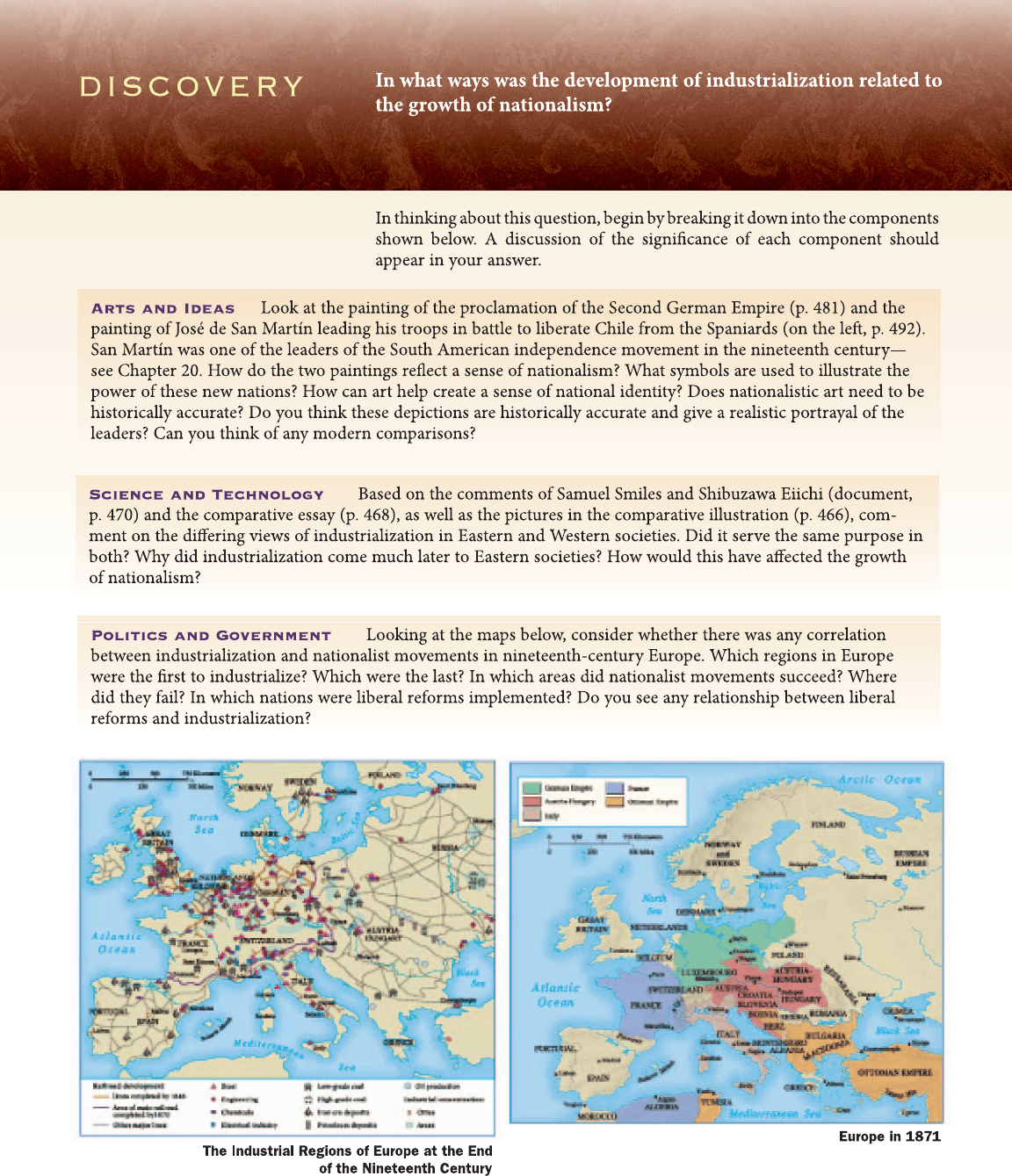
489
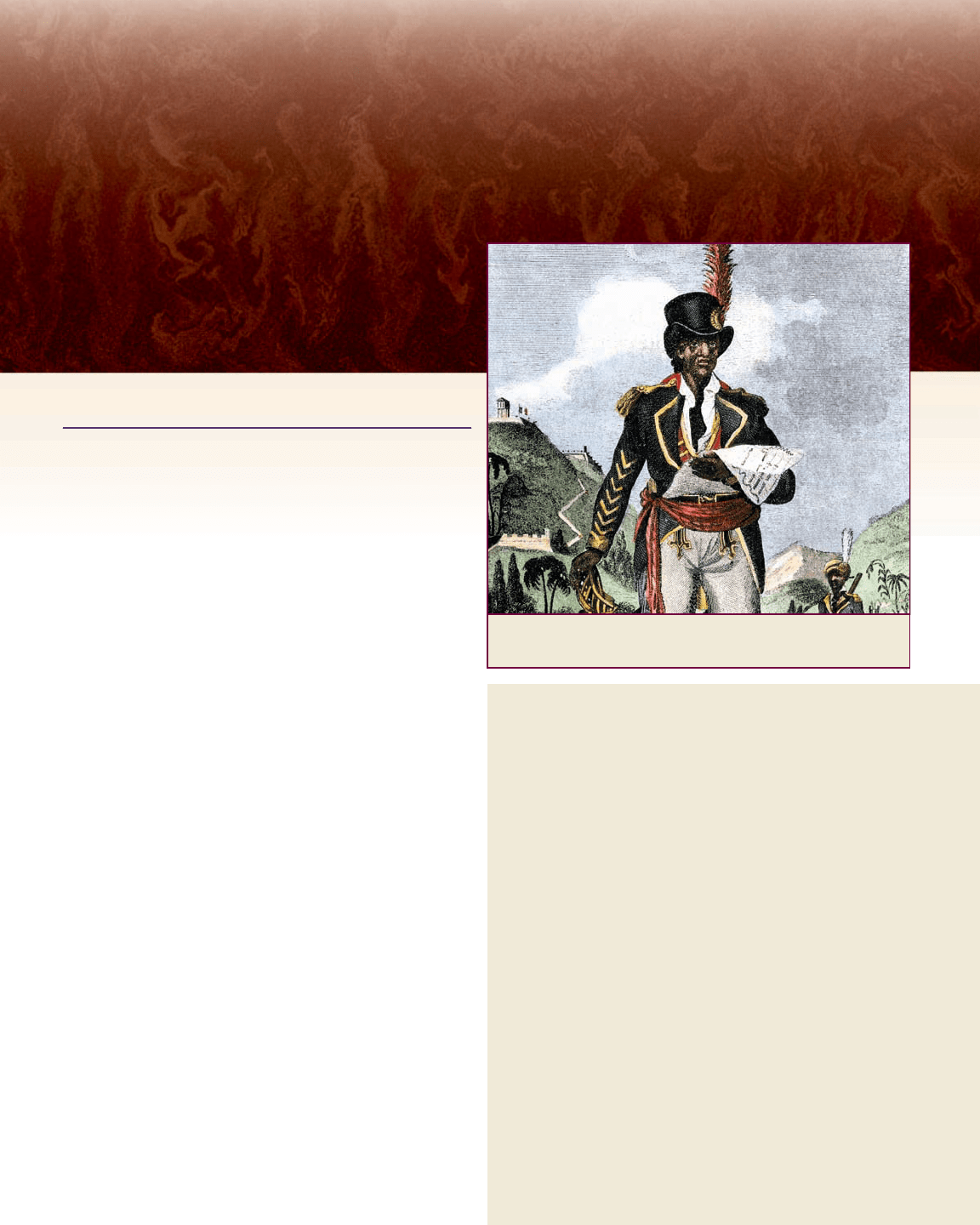
CHAPTER 20
THE AMERICAS AND SOCIETY AND CULTURE IN THE WEST
CHAPTER OUTLINE
AND FOCUS QUESTIONS
Latin America in the Nineteenth and Early
Twentieth Centuries
Q
What role did liberalism and nationalism play in Latin
America between 1800 and 1870? What were the major
economic, social, and political trends in Latin America
in the late nineteenth and early twentieth centuries?
The North American Neighbors:
The United States and Canada
Q
What role did nationalism and liberalism play in the
United States and Canada between 1800 and 1870? What
economic, social, and political trends were evident in the
United States and Canada between 1870 and 1914?
The Emergence of Mass Society
Q
What is meant by the term mass society, and what were
its main characteristics?
Cultural Life: Romanticism and Realism
in the Western World
Q
What were the main characteristics of Romanticism and
Realism?
Toward the Modern Consciousness:
Intellectual and Cultural Developments
Q
What intellectual and cultural developments in the late
nineteenth and early twentieth centuries ‘‘opened the
way to a modern consciousness,’’ and how did this
consciousness differ from earlier worldviews?
CRITICAL THINKING
Q
In what ways were the intellectual and cultural
developments in the Western world between 1800 and
1914 related to the economic, social, and political
developments?
A portrait of Toussaint L’Ouverture, leader of the Haitian
independence movement
c
North Wind Picture Archives
490
NATIONALISM---one of the major forces for change in Europe in
the nineteenth century---also affected Latin America as the colonial
peoples there overthrew their Spanish and Port uguese masters and
began the process of creating new national states. An unusual revo-
lution in Haiti preceded the main independence movements. Pierre
Dominique Toussaint L’Ouverture, the grandson of an African king,
was born a slave in Saint-Domingue---the western third of the island
of Hispaniola, a French sugar colony---in 1746. Educated by his god-
father, Toussaint was able to amass a small private fortune through
his own talents and the generosity of his French master. When black
slaves in Saint-Domingue, inspired by news of the French Revolu-
tion, revolted in 1791, Toussaint became their leader. For years,
Toussaint and his ragtag army struck at the French. By 1801, after
his army had come to control Saint-Domingue, Toussaint assumed
the role of ruler and issued a constitution that freed all slaves.
But Napoleon Bonaparte refused to accept Toussaint’s control
of France’s richest colony and sent a French army of 23,000 men
under General Leclerc, his brother-in-law, to crush the rebellion.
Although yellow fever took its toll on the French, the superior size
and weapons of their army enabled them to gain the upper hand.
Toussaint was tricked into surrendering in 1802 with Leclerc’s

Latin America in the Nineteenth
and Early Twentieth Centuries
Q
Focus Questions: What role did liberalism and
nationalism play in Latin Ameri ca between 1800 and
1870? What were the major economic, social, and
political trends in Latin America in the late nineteenth
and early twentieth centuries?
The Spanish and Portuguese colonial empires in Latin
America had been integrated into the traditional monar-
chical structure of Europe for centuries. When that
structure was challenged, first by the ideas of the
Enlightenment and then by the upheavals of the Napo-
leonic era, Latin America encountered the possibility of
change. How it responded to that possibility, however, was
determined in part by conditions unique to the region.
The Wars for Independence
By the end of the eighteenth century, the ideas of the
Enlightenment and the new political ideals stemming
from the successful revolution in North America were
beginning to influence the creole elites (descendants of
Europeans who became permanent inhabitants of Latin
America). The principles of the equality of all people in
the eyes of the law, free trade, and a free press proved very
attractive. Sons of creoles, such as Simo
´
n Bolı
´
var and Jos
e
de San Martı
´
n, who became leaders of the independence
movement, even went to European universities, where
they imbibed the ideas of the Enlightenment.
Nationalistic Revolts in Latin America The creole
elites soon began to use their new ideas to denounce the
rule of the Iberian monarchs and the peninsulars
(Spanish and Portuguese officials who resided in Latin
America for political and economic gain). As Bolı
´
var said
in 1815, ‘‘It would be easier to have the two continents
meet than to reconcile the spirits of Spain and America.’’
1
When Napoleon Bonaparte toppled the monarchies of
Spain and Portugal, the authority of the Spaniards and
Portuguese in their colonial empires was weakened, and
between 1807 and 1825, a series of revolts enabled most
of Latin America to become independent.
The first revolt was actually a successful slave rebel-
lion. As we have seen, Toussaint L’Ouverture (1746--1803)
led a revolt of more than 100,000 black slaves and seized
control of all of Hispaniola. On January 1, 1804, the
western part of the island, now called Haiti, announced
its freedom and became the first independent postcolo-
nial state in Latin America.
Beginning in 1810, Mexico, too, experienced a revolt,
fueled initially by the desire of the creole elites to over-
throw the rule of the peninsulars. The first real hero of
Mexican independence was Miguel Hidalgo y Costilla, a
parish priest in a small village about 100 miles from
Mexico City. Hidalgo had studied the French Revolution
and roused the local Indians and mestizos, many of
whom were suffering from a major famine, to free
themselves from the Spanish. On September 16, 1810, a
crowd of Indians and mestizos, armed with clubs, ma-
chetes, and a few guns, quickly formed a mob army to
attack the Spaniards, shouting, ‘‘Long live independence
and death to the Spaniards.’’ But Hidalgo was not a good
organizer, and his forces were soon crushed. A military
court sentenced Hidalgo to death, but his memory lived
on. In fact, September 16, the first day of the uprising, is
celebrated as Mexico’s Independence Day.
The participation of Indians and mestizos in
Mexico’s revolt against Spanish control frightened both
creoles and peninsulars. Fearful of the masses, they co-
operated in defeating the popular revolutionary forces.
The elites---both creoles and peninsulars---then decided to
overthrow Spanish rule as a way of preserving their own
power. They selected a creole military leader, Augustı
´
nde
Iturbide, as their leader and the first emperor of Mexico
in 1821. The new government fostered neither political
nor economic changes, and it soon became apparent that
Mexican independence had benefited primarily the creole
elites.
LATIN AME RICA IN THE NINETEENTH AND EARLY TWENTIETH CENTURIES 491
promise: ‘‘You will not find a more sincere friend than myself.’’ What
a friend! Toussaint was arrested, put in chains, and shipped to
France, where he died a year later in a dungeon. The western part of
Hispaniola, now called Haiti, however, became the first independent
state in Latin America when Toussaint’s lieutenants drove out the
French forces in 1804. Haiti was only one of a number of places in
the Americas where new nations were formed during the nineteenth
century. Indeed, nation building was prominent in North America as
the United States and Canada expanded.
As national states in both the Western Hemisphere and Europe
were evolving in the nineteenth century, significant changes were oc-
curring in society and culture. The rapid economic changes of the
nineteenth century led to the emergence of mass society in the West-
ern world, which meant improvements for the lower classes, who
benefited from the extension of voting rights, a better standard of
living, and universal education. The coming of mass society also cre-
ated new roles for the governments of nation-states, which now fos-
tered national loyalty, created mass armies by conscription, and took
more responsibility for public health and housing measures in their
cities. Cultural and intellectual changes paralleled these social devel-
opments, and after 1870, Western philosophers, writers, and artists
began exploring modern cultural expressions that questioned tradi-
tional ideas and increasingly provoked a crisis of confidence.
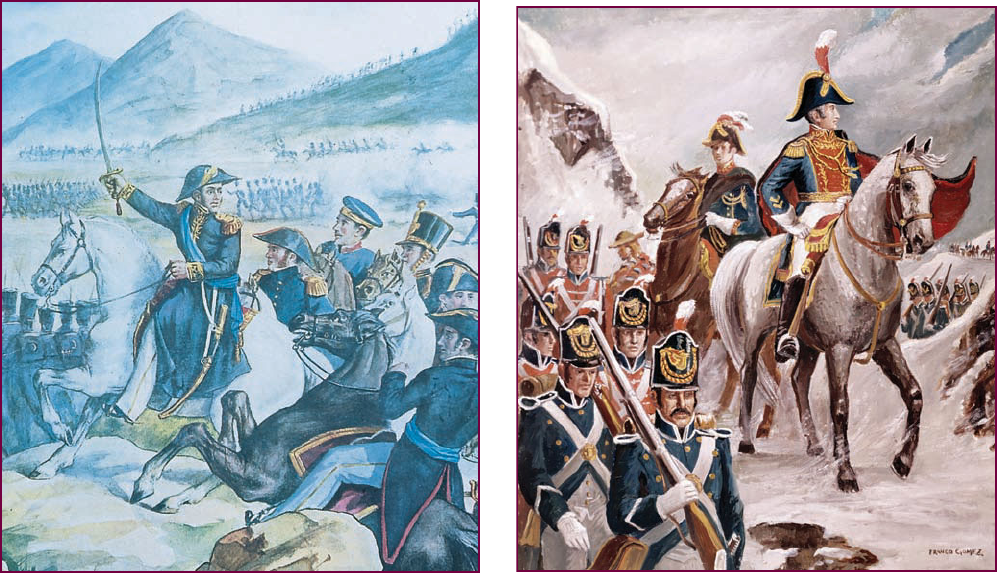
Independence movements elsewhere in Latin Amer-
ica were likewise the work of elites---primarily creoles---
who overthrew Spanish rule and set up new governments
that they could dominate. Jos
e de San Martı
´
n (1778--
1850) of Argentina and Simo
´
n Bolı
´
var (1783--1830) of
Venezuela, leaders of the independence movement, were
both members of the creole elite, and both were hailed as
the liberators of South America.
The Efforts of Bolı
´
var and San Martı
´
n Simo
´
nBolı
´
var
has long been regarded as the George Washington of
Latin America. Born into a wealthy Venezuelan family, he
was introduced as a young man to the ideas of the En-
lightenment. While in Rome in 1805 to witness the cor-
onation of Napoleon as king of Italy, he committed
himself to free his people from Spanish control. He
vowed, ‘‘I swear before the God of my fathers, by my
fathers themselves, by my honor and by my country, that
my arm shall not rest nor my mind be at peace until I
have broken the chains that bind me by the will and
power of Spain.’’
2
When he returned to South America,
Bolı
´
var began to lead the bitter struggle for independence
in Venezuela as well as other parts of northern South
America. Although he was acclaimed as the ‘‘liberator’’ of
Venezuela in 1813 by the people, it was not until 1821
that he definitively defeated Spanish forces there. He went
on to liberate Colombia, Ecuador, and Peru. Already in
1819, he had become president of Venezuela, at the time
part of a federation that included Colombia and Ecuador.
Bolı
´
var was well aware of the difficulties in establishing
stable republican governments in Latin America (see the
box on p. 493).
While Bolı
´
var was busy liberating northern South
America from the Spanish, Jos
e de San Martı
´
nwascon-
centrating his efforts on the southern part of the continent.
Son of a Spanish army officer in Argentina, San Martı
´
n
himself went to Spain and pursued a military career in the
Spanish army. In 1811, after serving twenty-two years, he
learned of the liberation movement in his native Argentina,
abandoned his military career in Spain, and returned to his
homeland in Mar ch 1812. Argentina had already been
freed from Spanish control, but San Martı
´
n believed that
the Spaniards must be removed from all of South America
if any nation was to be free. In January 1817, he led his
c
The Art Archive/Museo Nacional de Historia, Lima, Peru/Gianni Dagli Orti
c
Superstock
The Liberators of South America. Jos
e de San Martı
´
n and Simo
´
n Bolı
´
var are hailed as the leaders
of the South American independence movement. In the painting on the left, by Theodore G
ericault, a French
Romantic painter, San Martı
´
n is shown leading his troops at the Battle of Chacabuco in Chile in 1817. The
painting on the right shows Bolı
´
var leading his troops across the Andes in 1823 to fight in Peru. This
depiction of perfectly uniformed troops moving in neat formation through the snow of the Andes, by the
Chilean artist Franco Gomez, is, of course, highly unrealistic.
492 CHAPTER 20 THE AMERICAS AND SOCIETY AND CULTURE IN THE WEST

forces ov er the high Andes M ountains, an amazing feat in
itself. Two-thirds of their pack mules and horses died
during the difficult journey. Many of the soldiers suffer ed
from lack of oxygen and severe cold while crossing
mountain passes more than 2 miles abov e sea level. The
arrival of San Martı
´
n’s troops in Chile completely surprised
theSpaniards,whoseforceswereroutedattheBattleof
Chacabuco on February 12, 1817.
In 1821, San Martı
´
n moved on to Lima, Peru, the
center of Spanish authority. Convinced that he was unable
to complete the liberation of all of Peru, San Martı
´
n
welcomed the arrival of Bolı
´
var and his forces. As he wrote
to Bolı
´
var, ‘‘For me it would have been the height of
happiness to end the war of independence under the or-
ders of a general to whom [South] America owes its
freedom. Destiny orders it otherwise, and one must resign
oneself to it.’’
3
Highly disappointed, San Martı
´
nleftSouth
America for Europe, where he remained until his death
in 1850. Mean while, Bolı
´
var took on the task of crushing the
last significant Spanish army at Ayacucho on December 9,
1824. By then, Peru, Uruguay, Paraguay, Colombia, Ven-
ezuela, Argentina, Bolivia, and Chile had all become free
states (see Map 20.1). In 1823, the Central American states
became independent and in 1838--1839 divided into five
republics (Guatemala, El Salvador, Honduras, Costa Rica,
and Nicaragua). Earlier, in 1822, the prince regent of
Brazil had declared Brazil’s independence from Portugal.
Independence and the Monroe Doctrine In the early
1820s, only one major threat remained to the newly won
independence of the Latin American states. Reveling in
their success in crushing rebellions in Spain and Italy, the
victorious continental European powers favored the use
of troops to restore Spanish control in Latin America.
This time, Britain’s opposition to intervention prevailed.
Eager to gain access to an entire continent for investment
SIMO
´
N BOLI
´
VA R O N GOVERNMENT IN LATIN AMERICA
Simo
´
n Bolı
´
var is acclaimed as the man who liber-
ated Latin America from Spanish control. His inter-
est in history and the ideas of the Enlightenment
also led him to speculate on how Latin American
nations would be governed after their freedom was obtained.
This selection is taken from a letter written to the British
governor of Jamaica.
Simo
´
n Bolı
´
var, The Jamaica Letter
It is ...difficult to foresee the future fate of the New World, to set
down its political principles, or to prophesy what manner of govern-
ment it will adopt. ... We inhabit a world apart, separated by broad
seas. We are young in the ways of almost all the arts and sciences,
although in a certain manner, we are old in the ways of civilized
society. ... But we scarcely retain a vestige of what once was; we
are, moreover, neither Indian nor European, but a species midway
between the legitimate proprietors of this country and the Spanish
usurpers. In short, though Americans by birth we derive our rights
from Europe, and we have to assert these rights against the rights of
the natives, and at the same time we must defend ourselves against
the invaders. This places us in a most extraordinary and involved
situation. ...
The role of the inhabitants of the American hemisphere has
for centuries been purely passive. Politically they were non-existent.
We are still in a position lower than slavery, and therefore it is
more difficult for us to rise to the enjoyment of freedom. ... States
are slaves because of either the nature or the misuse of their con-
stitutions; a people is therefore enslaved when the government, by
its nature or its vices, infringes on and usurps the rights of the
citizen or subject. Applying these principles, we find that America
was denied not only its freedom but even an active and effective
tyranny. ...
It is harder, Montesquieu has written, to release a nation from
servitude than to enslave a free nation. This truth is proven by the
annals of all times, which reveal that most free nations have been put
under the yoke, but very few enslaved nations have recovered their
liberty. Despite the convictions of history, South Americans have
made efforts to obtain liberal, even perfect, institutions, doubtless out
of that instinct to aspire to the greatest possible happiness, which,
common to all men, is bound to follow in civil societies founded on
the principles of justice, liberty, and equality. But are we capable of
maintaining in proper balance the difficult charge of a republic? Is it
conceivable that a newly emancipated people can soar to the heights
of liberty ...? Such a marvel is inconceivable and without precedent.
There is no reasonable probability to bolster our hopes.
More than anyone, I desire to see America fashioned into the
greatest nation in the world, greatest not so much by virtue of her
area and wealth as by her freedom and glory. Although I seek per-
fection for the government of my country, I cannot persuade myself
that the New World can, at the moment, be organized as a great re-
public. Since it is impossible, I dare not desire it; yet much less do I
desire to have all America a monarchy because this plan is not only
impracticable but also impossible. Wrongs now existing could not
be righted, and our emancipation would be fruitless. The American
states need the care of paternal governments to heal the sores and
wounds of despotism and war.
Q
What problems did Bolı
´
var foresee for Spanish America’s
political future? Do you think he believed in democracy? Why or
why not?
LATIN AME RICA IN THE NINETEENTH AND EARLY TWENTIETH CENTURIES 493
